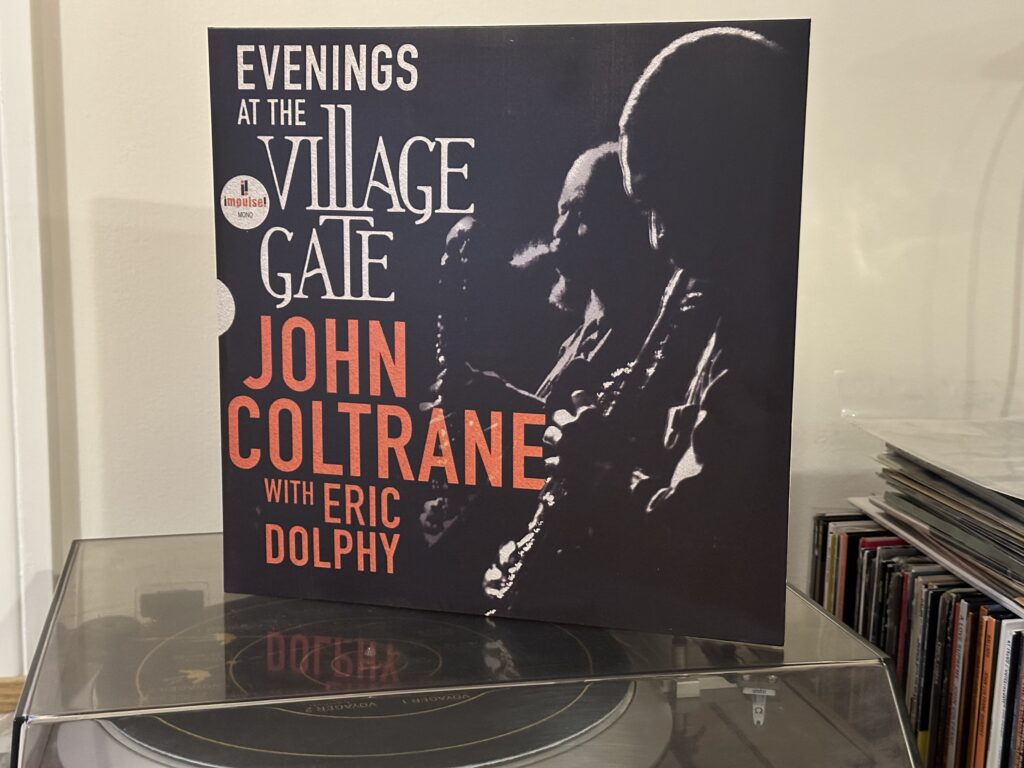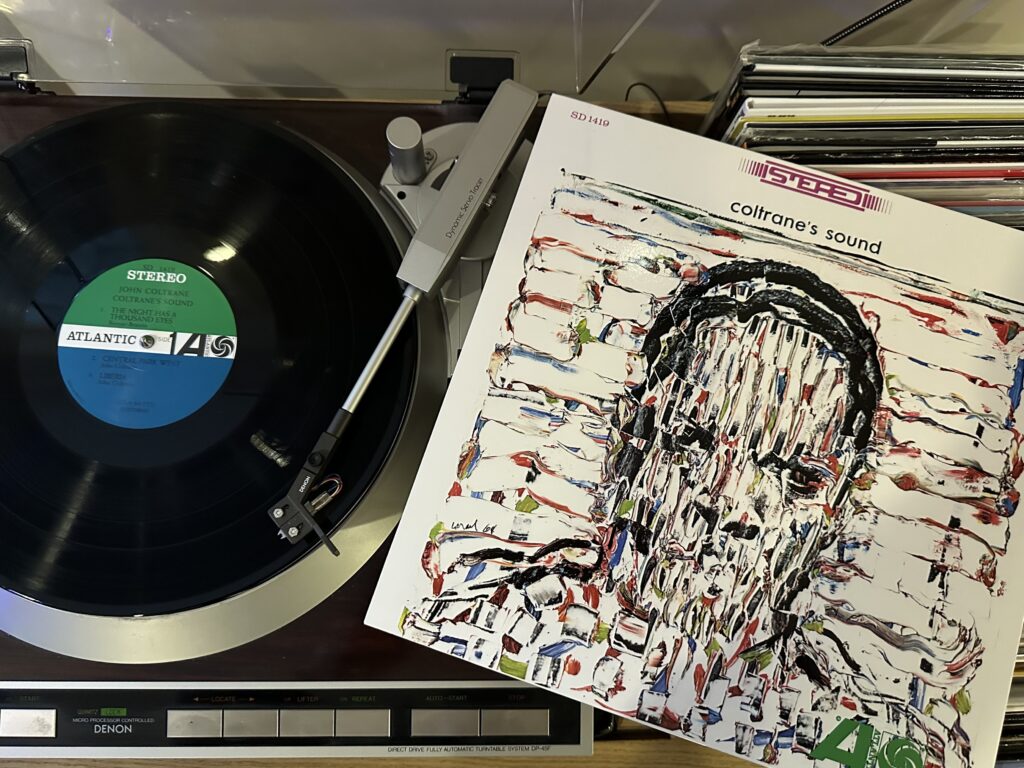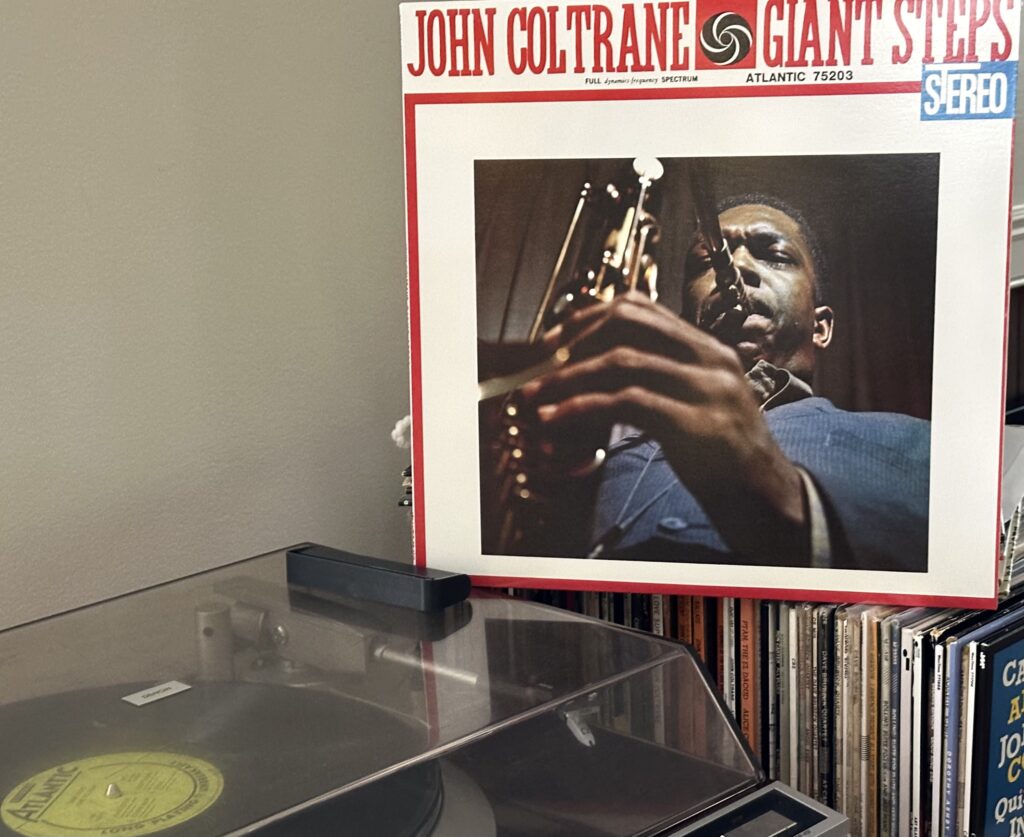
Album of the Week, January 20, 2024
In the early 1960s, John Coltrane’s studio recordings were expressive and harmonically innovative, but still followed a recognizable jazz form: statement of the melody, or head; solos that were structured around the chords of the melody; a recapitulation of the head. But other musicians were starting to innovate on that form, moving away from the structure of playing over the chord changes. Miles moved to improvisation over modal scales, as we’ve seen. And other musicians went even further, rejecting consistent chords in favor of more unlimited explorations. Ornette Coleman’s 1960 album Free Jazz gave the movement a name, and others explored its ideas. One of the most promising of them was saxophonist and flautist Eric Dolphy. And when Dolphy met Trane, it changed the older composer’s trajectory.
Trane and Dolphy had met years previously in Los Angeles, and when Trane began performing in New York in the summer of 1961, he invited Dolphy to join his group. Additionally, his group included two bassists; Trane liked the freedom the second bass offered to have both a constant “ground” or repeated fundamental note in the chord, while the other bassist was free to be a more melodic voice. So the group included Dolphy, Reggie Workman (who had replaced Steve Davis), Art Davis, and Elvin Jones and McCoy Tyner from Trane’s quartet, last heard on Coltrane’s Sound.
Until recently, the main documentation for Trane’s New York sessions with Dolphy consisted of recordings from his residencies at the Village Vanguard in the fall of 1961, including 1962’s Live! At the Village Vanguard and half the tracks on 1963’s Impressions; both recordings have Jimmy Garrison replacing Art Davis. But last year a recording was found at the New York Public Library of an earlier residency, from July 1961, at the Village Gate. The recording shows off Trane’s emerging free concept at a transitional moment. Much of the repertoire is familiar from his 1961 releases, but the performances are very different.
Where the studio version of “My Favorite Things” begins with a modal progression and a clear statement of the theme, this live version jumps right in with an extended Eric Dolphy flute solo. It’s actually not clear from the recording whether the song begins here or if the recording started after the statement of the theme, but he improvises for an extended period over the minor chords of theme, eventually coming into a statement of the second eight bars of the melody (ending in “these are a few of my favorite things”) before entering another extended improvisation. He finally brings this solo to a close some six minutes in, and Trane steps up on soprano sax, stating the theme before signalling the beginning of his improvisation with a sustained blast on the tonic. His solo hugs the high end of the range, stretching out the ideas in his solos on the studio version. A phrase that might have occupied a measure or two on My Favorite Things here gets extended to 16 or 32 bars, with Trane continually extending and searching forward. Beneath the solos, Elvin Jones continually propels the beat forward. On this archival recording live recording, the bass is less audible than if Rudy Van Gelder were taping, but you can hear both the constant ground and the melodic improvisation of the two players.
“When Lights are Low” has both a straight version of the melody and a keening dervish-like improvisation from Trane’s soprano sax. Dolphy anchors the low end of the line with his bass clarinet, underpinning the dizzying improvisation of Trane’s soprano sax with an earthier tone. Tyner gets a solo that sounds more conventionally structural than anything else in the 80 minute long set, but which is almost as equally searching within the limits of chromatic tonality as some of Trane’s Pentecostal honks. Throughout, Jones continues to drop explosions. I once saw the Elvin Jones Jazz Machine in Old Cabell Hall at the University of Virginia, in 1993; at the age of 66, he was easily the most muscular and dramatic player I saw that weekend, and you can hear his work throughout this set.
“Impressions” is a track that Trane never released on a studio album; the only two studio recordings extant weren’t released until 2018—but the many live performances he did often featured the track, including its appearance on the 1963 half-live album that is its namesake. Here the track has all its hallmark features—the use of the “So What” chords, especially the uptempo live version that Miles preferred and that features on the Live in Copenhagen recording. Trane takes a shorter solo here and lets Dolphy and Tyner explore the sounds before stepping back up to close out the tune. It feels more formal and less wild than the version from Impressions, recorded just four months later, but the seeds of the approach were clearly already planted.
Trane finished the set with “Greensleeves” and “Africa,” both of which featured on his Africa/Brass album, which was still about six weeks from release at the time of these sessions. “Greensleeves” feels a lot like the “My Favorite Things” arrangement, anchored in a modal two-chord pivot that Tyner keeps going throughout the arrangement, but made wild and new by Trane’s explorations. Dolphy is mostly in the background on bass clarinet for these cuts as Trane explores the sound being created by the group. When the horns drop away, leaving a Tyner-anchored piano trio, it’s almost a shock, even as Tyner’s powerful clustered chords keep the momentum of the full band track going. “Africa” is a wilder, looser tune, less anchored in chords and more a free modal exploration. It also features the one part of the set where you can clearly hear what Reggie Workman and Art Davis were up to, in an eight minute long duet. Workman’s melodic playing explored the upper end of the instrument’s register before finding a rhythmic dance against percussive string slaps and a grounding thrum from Davis. Jones takes center stage as well, dislodging the pulse in space and time, before Dolphy and Trane return for a final hurrah—and applause from what sounds like a small audience in the club.
Trane’s group with Dolphy would last almost through the end of the year. Ultimately Dolphy moved on to play with Charles Mingus, where he could play a more central role in the sound of the group; Reggie Workman would move on as well following a European tour. Ultimately Trane found a mixed reception for his experiments with Dolphy, with some critics calling the sound “anti-jazz.” He would regroup in the following year and take his sound in another very different direction. Before we check in on the outcomes of those explorations, though, we’ll listen a little more closely to what some of his sidemen were bringing to the table.
You can listen to this week’s album here:


